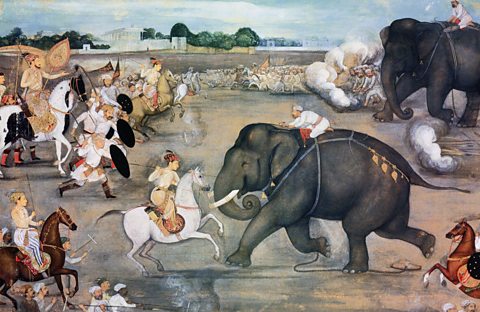Key points
- The Mughal Empire began in 1526 and lasted for over 200 years. At its peak it covered modern day India, Pakistan and Afghanistan.
- The empireWhen a group of countries, states or territories is ruled over by a single country or ruler. was founded by Babur, a Muslim warrior prince from Central Asia, who descended from the MongolThe Mongols are a people from Mongolia. They are often nomadic, which means they travel from place to place rather than settling in a single location. The Mongols were famous for their skill with horses and in warfare. They speak Mongolian and are usually Buddhist..
- The Mughal emperors were Muslim and most of their subjects were Hindu so it was important that the Mughal emperors supported religious tolerance When people are allowed to practice their religion freely and are treated equally..
Video about the Mughal Empire
The Mughal Empire ruled over most of modern India, Pakistan and Afghanistan in the 16th, 17th, and 18th centuries. In the early 16th century, a warrior prince named Babur marched east from central Asia, conquering huge areas of land.
Babur was descended from the Mongols who governed much of central Asia including Persia; part of which is now known as Iran. Babur had great military skill. In 1526, he took control of Delhi and the Mughal Empire was founded. Although the Empire was created by Baburâs military victories and conquests, it was not until the reign of Akbar, the 3rd emperor, that the empire began to flourish.
The Mughals were accepting of the cultures and people they ruled over. They were Muslims but they ruled over a vast population of Hindus, Muslims and other faiths. They were largely tolerant of other religions. They allowed Hindus to practice their religion, built lots of temples and appointed many Hindus to senior government and military positions.
Akbar established the Ibadat Khana or House of Worship. He invited scholars, philosophers and religious leaders to discuss spiritual matters. The multicultural aspect of the empire led to some unique developments. The Ultu language flourished, which mixed Persian vocabulary, Arabic script and Hindi grammar.Under Mughal rule, unique works of art and architecture that blended Persian and Hindustani traditions were created. For example, the Taj Mahal, built during the reign of Shah Jahan, the 5th Mughal emperor.
The military conquests continued as the empire grew in size and become very wealthy. This wealth came partly from selling goods to Portuguese, British and other foreign traders.
The 6th emperor, Aurangzeb, a devout Muslim was much less tolerant of other faiths. His long reign saw many rebellions while his conquests in the south stretched the empire too thin. A succession of weak leaders, violent uprisings and economic difficulties saw the Mughal Empire decline in the 18th century.
The capital Delhi was raided in 1739 by the Shah of Persia and the Mughals lost much territory to the Maratha invasion. The British East India Company began to seize lands to gain control of trade and wealth. In 1857, the Mughal Empire was formerly dissolved by the British when they made India part of their empire.
The first three emperors
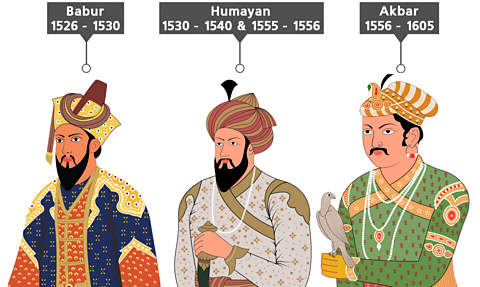
Prince Babur founds the Mughal Empire
Babur was born a prince in Central Asia. At only 12 years old he became ruler of an area called Ferghana, a city in modern day Uzbekistan. This meant at a very young age he became a successful and skilled warrior.
Some historians believe that in the early 1500s Babur was invited to India by Indian princes who wanted to overthrow their ruler. While there is not enough evidence for all historians to be sure of this we do know that by 1526, Babur had travelled south with his men and taken control of Delhi â founding the Mughal Empire.
Where did the name âMughalâ come from?
Mughal is the Persian-Arabic term for Mongol. As Akbar was a descendent of the Mongol leader, Genghis Khan, the rulers of the new Indian Empire were given the name âMughalsâ.
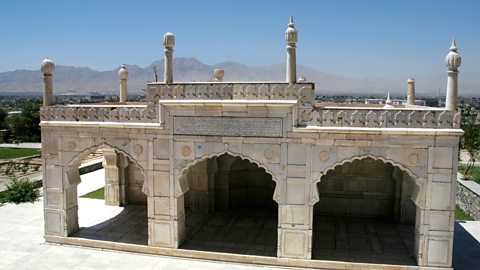
Image caption, One of the small mosques that still stands in the garden of Babur
Image caption, Flower arrangements in the garden of Babur during the traditional Namangan Flowers Festival
Image caption, A drawing of the tomb of Babur, by William Daniell
1 of 3
Over the next 4 years, Babur fought many battles to take control of northern India. While he was successful in these battles, they came at a huge cost. After only 4 years Babur died of natural causes, and the Mughal Empire was left with very little money.
However, Babur did achieve many important things for the future of the Mughal Empire:
- Babur began to build a large library of books and manuscripts. This would help the Mughal Empire become an important source of knowledge.
- Babur built a grand palace in his capital city, Agra. This grand palace would be the first of many large, impressive buildings that symbolised Mughal culture.
- In 1528, Babur built a walled garden around his palace, known today as the Gardens of Babur. It is one of the oldest surviving Mughal gardens that shows how Mughal emperors brought the cultures and traditions of Central Asia down to India.
Humayun struggles to keep control of the early Mughal empire
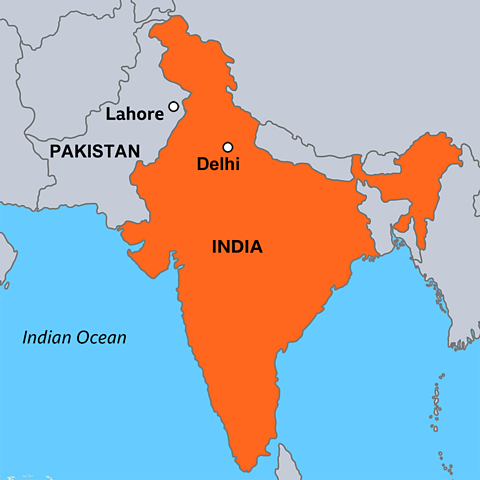
After Babur died, his son Humayun became emperor. At this time, the Mughal Empire was still growing and needed a strong military leader to protect and expand the empire.
However, Humayun was seen as a weak military ruler, due to the fact that he preferred poetry to fighting or leading his army in war. He faced many challenges from his half-brothers and was even forced into exile from 1540 - 1555.
After making an alliance with Shah áčŹahmÄsp in Iran in 1544, Humayun took his new army back to India and took control of Lahore and Delhi in 1555.
Humayun then began to set up a new system that would increase the taxMoney paid to a ruler of a country/state. from the different regions to help make the money the Mughal Empire needed to survive. Unfortunately, Humayun died the following year, in an accident falling down the stairs in front of his library, before this system could be introduced.

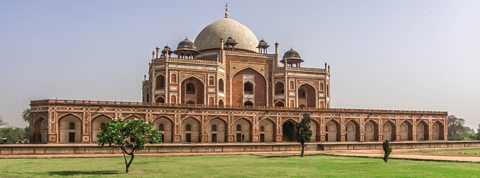
Akbar takes control of the Mughal Empire
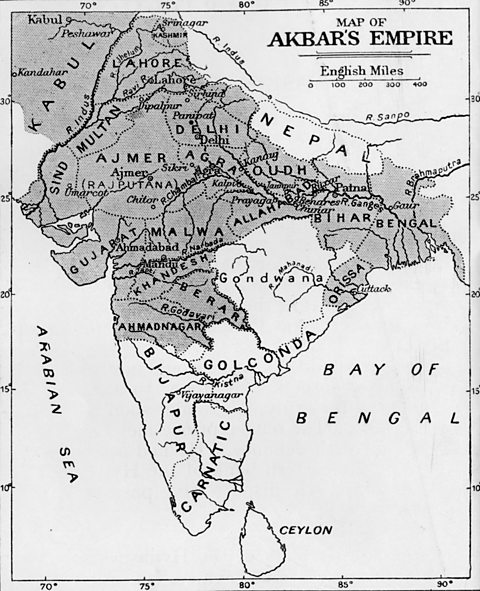
In 1556, Akbar took control of the Mughal Empire. At this time the empire covered the Punjab and a small area around Delhi, but by the end of his reign, Akbar had expanded the empire to cover most of modern-day India. Many historians consider his rule to be the âGolden Ageâ of the Mughal Empire.
Akbar faced several problems when he became ruler of the Mughal Empire:
- He needed more money to maintain his empire.
- He had to prove he was a better military ruler than his father, Emperor Humayun.
- He had to figure out how he could rule a Hindu empire with a small group of Muslim leaders.
For the first 5 years, the empire was ruled by his guardian since he was only 13. However, when Akbar turned 18 he quickly began to prove himself as a strong emperor after forcing his guardian, Bairam Khan, to retire.

Timeline of Akbarâs conquests
| Date | Event |
|---|---|
| 1561 | Attacked Malwa and took control of Deccan. |
| 1562 | Akbar made peace with the Rajputs in the Rajputana. After this, Hindu leaders were allowed to keep control of their land so long as they promised to acknowledge Akbar as ruler. |
| 1568 | Akbar massacres the people of Chittor for not acknowledging him as ruler. |
| 1573 | Akbar conquered Gujarat, which had many ports. This meant Akbar gained control of much of Indiaâs trade. |
| 1576 | After defeating and killing the ruler of Bengal, Daud Khan Karrani, Akbar brought Bengal under the control of the Mughal empire. |
| 1586 | The Kashmir region was brought under the control of the Mughal empire. |
| 1591 | The Sindh region was brought under the control of the Mughal empire. |
| 1595 | Kandahar, modern day Afghanistan, was brought under the control of the Mughal empire. |
| 1601 | Akbar decided to expand his empire south, Akbar took control of Khandesh, Berar and Ahmadnagar. |
However, Akbar did not just take over more land. He made changes to the way the empire was run so that he would be able to maintain such a large empire.
Akbar introduced a new tax system called Dahsala. He also introduced Zamindars, these were local tax collectors who worked for the emperor. The Zamindars would be important men in their local area, often Hindus. Their work meant that the emperor could collect all the money he needed without having to disturb the everyday life of his subjects.
By allowing Indian princes to keep their land and other Hindu noblemen to become Zamindars he was able to turn his Hindu enemies into alliesWhen two or more countries, groups or people make an agreement that they will support and defend each other they become allies. and supporters of his empire.
Were the Mughals the first Muslim rulers of India?
No. There had been Muslim rulers in India from the 13th century. In 1206, the Delhi Sultanate ruled much of modern day India, but they did not stay in power for long and broke down into smaller provinces that would be controlled by local Indian princes.
Religion and culture in the Mughal Empire
To keep peace and control in his empire Akbar had to do more than offer land and jobs to Hindu nobles, he had to enforce religious tolerance through the empire.
In 1580, Akbar ended the Jizyah. This was a tax that all non-Muslims had to pay to the emperor, by ending this hated tax he won the support of many Hindus. In the same year Akbar also introduced something Sulh-I kul, which is an Arabic term that means âpeace with allâ. As a result of Sulh-I kul, all Muslims and non-Muslims had the same rights.
Although it offended some of his closest Muslim officers, he would also encourage conversations between Hindus, ParsisA group of people from Persia who worship one God, called Ahura Mazda, who fled persecution from Muslim rulers in Persia. They are descendants of one of the oldest religions in the world., Muslims and Christians at the House of Worship he built called Ibadat Khana. He even welcomed JesuitsA group of Catholics who travelled across Europe and Asia from the 16th century, their goal was to convert people to Christianity. from Europe and had conversations with them about Christianity. While Akbar never converted from Islam, he showed a strong interest in developing his knowledge about many faiths and cultures.
Was Akbar always tolerant towards Hindus?
Akbar was mostly tolerant within the Mughal Empire, however this was not always the case as he expanded his empire.
In 1567-8, Akbar wanted to take control of the city of Chittor. After 4 months of battles, Akbar was able to take control of the fort and ordered the massacre of the people of Chittor. This included 30,000 Hindu civilians, as well as many women and children who were taken as prisoners of war.
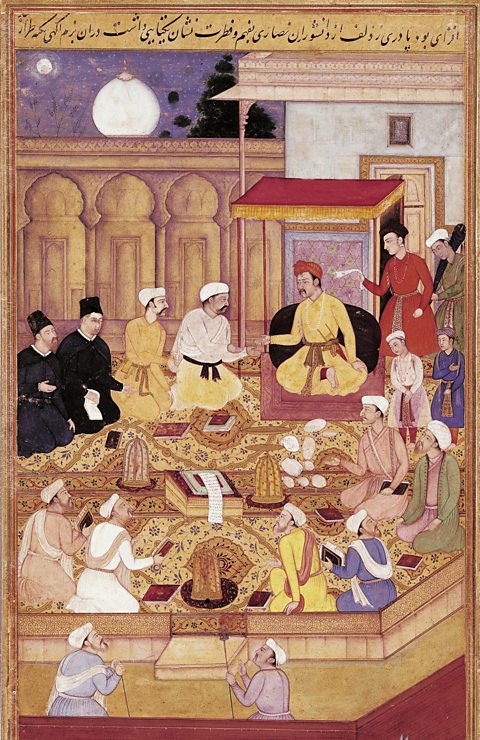
Test your knowledge
Play the History Detectives game! gamePlay the History Detectives game!
Analyse and evaluate evidence to uncover some of historyâs burning questions in this game.

More on Mughal India (1526-1857)
Find out more by working through a topic
- count2 of 3
